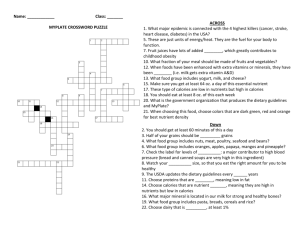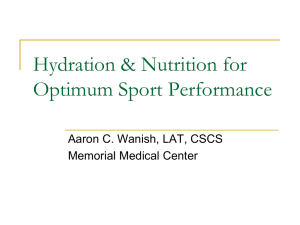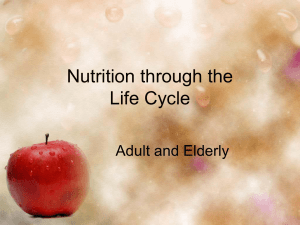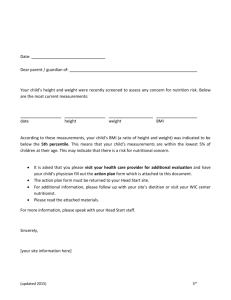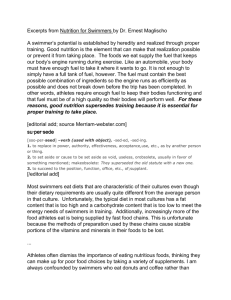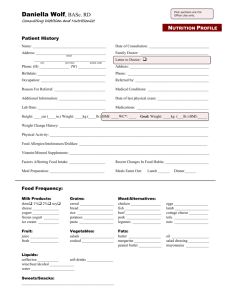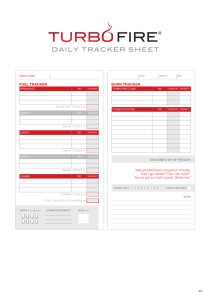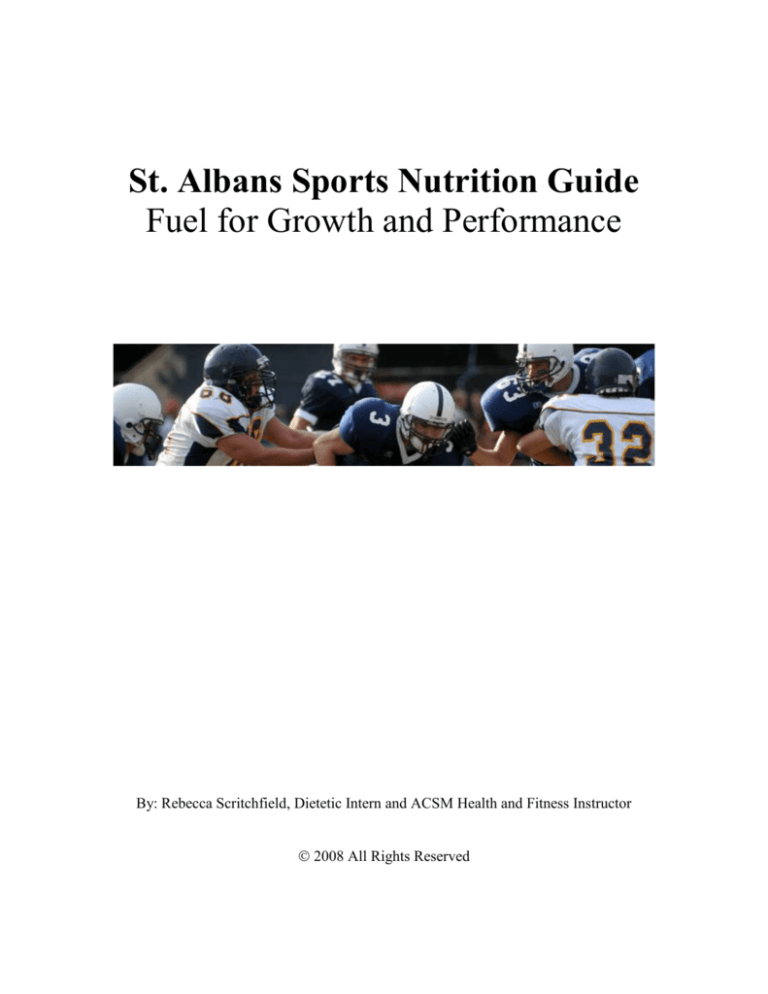
St. Albans Sports Nutrition Guide
Fuel for Growth and Performance
By: Rebecca Scritchfield, Dietetic Intern and ACSM Health and Fitness Instructor
2008 All Rights Reserved
Table of Contents
Introduction ..................................................................................................................... 1
How This Guide Will Help ......................................................................................... 1
Taking It to the Next Level ......................................................................................... 1
Nutrition Needs ........................................................................................................... 2
Energy ......................................................................................................................... 2
Nutrients ...................................................................................................................... 3
Sleep ............................................................................................................................ 8
The Athlete’s Diet ....................................................................................................... 8
Breakfast ..................................................................................................................... 9
Lunch .......................................................................................................................... 9
Dinner ....................................................................................................................... 10
Snacks ....................................................................................................................... 11
Recovery ................................................................................................................... 11
Game Day Nutrition ...................................................................................................... 12
Meal timing ............................................................................................................... 12
Hydration .................................................................................................................. 13
Pre-Game Meal ......................................................................................................... 13
Eating During the Game ........................................................................................... 14
Recovery Snack ........................................................................................................ 14
Post-Game Meal........................................................................................................ 14
Nutrition for Fitness Goals............................................................................................ 15
Weight Gain .............................................................................................................. 15
Weight Loss .............................................................................................................. 16
Supplements .................................................................................................................. 17
What Is Considered A “Supplement”? ..................................................................... 17
Safety Concerns ........................................................................................................ 17
Vitamins and Minerals .............................................................................................. 18
Restaurants, Fast Food, and Junk Food .................................................................... 19
Resources ...................................................................................................................... 19
Books and Videos ..................................................................................................... 20
Websites .................................................................................................................... 20
Introduction
Nutrition matters. It’s that simple. A sound nutrition plan is the foundation for a strong a
powerful athlete. Good nutrition can help maximize overall performance by helping to
reduce muscle soreness and boost energy during exercise. Unfortunately, nutrition is the
most overlooked aspect of athletics. As a result, most young athletes don’t get the proper
nutrition to perform their best. Good nutrition habits are worth developing because they
will help you enjoy your sport for many years to come.
How This Guide Will Help
This guide is an introduction to basic nutrition principles for healthy, active young adults
with a particular focus on male athletes nutrition needs. By reading this guide, you should
be able to understand why nutrition is important for optimal growth and performance and
how nutrition can help you meet your fitness goals.
Taking It to the Next Level
Serious athletes are serious about nutrition. This guide provides generalized advice,
although the needs of athletes can be very specific. The best thing you can do if you are
serious about nutrition is seek the advice of a registered dietitian (RD). A dietitian is a
credential health professional who has received extensive academic and field training in
nutrition. Dietitians can conduct a nutrition assessment and estimate if you are meeting
your nutrition needs to support your sport. They can help you work within any food
preferences, allergies, or existing health conditions in which nutrition plays a vital role.
When considering a dietitian, you may want to look for a professional who has additional
training in exercise and sports nutrition. Many dietitians are also certified personal
trainers or health and fitness instructors through the American College of Sports
Medicine (ACSM) or National Academy of Sports Medicine (NASM). You can find a
dietitian through the American Dietetic Association website, www.eatright.org or the
practice group of Sports, Cardiovascular and Wellness Nutritionists (SCAN) at
www.scandpg.org.
Best wishes for many years of healthy activity!
Rebecca, ACSM HFI
About Rebeccca
Rebecca Scritchfield has more than a decade of experience in the health and wellness
field as a personal trainer, group exercise instructor, and corporate health consultant. She
has a bachelor’s degree in nutrition and a master’s degree in communications from the
Johns Hopkins University. Rebecca compiled this guide during her sports nutrition
rotations in her dietetic internship. She expects to obtain the RD credential after
successfully passing the board exam in 2008. Her website is
www.rebeccascritchfield.com.
Nutrition Needs
Energy
Listening to your body cues is an easy way to manage your energy intake. So eat when
you are hungry and stop when you are full. That said you should make sure you are
meeting the minimum requirements for energy so you have the fuel for your workouts
and games. Most athletes do not get the calories they need, especially on game days.
You can meet your energy needs by eating 4 to 5 times a day, everyday. Include a small
meal within 30 minutes of finishing workouts. You will learn more about recovery meals
in the next section. If you are trying to gain weight, you should eat two snacks between
your three meals plus your recovery small meal – so 6 times a day! You will learn more
about weight gain later in the guide.
Table 1. Energy Needs for Young Adults
Age
11-14
15-18
Male
2,500
3,000
Female
2,200
2,200
You will need additional calories to support your workouts and games. The calorie needs
depends on the type of sport, duration of the activity and the athlete’s body weight. As a
result, it is difficult to generalize calorie recommendations. Assume at least an additional
500 calories on training and game days, although you could burn much more than that.
Your body will respond with increased hunger in the few hours after the activity. You
should listen to the hunger cue and eat larger portions.
Breakdown of Estimated Calorie Needs
General Nutrition Needs
11-14 year-old males need 2,500 calories a day
15-18 year-old males need 3,000 calories a day
You will reach 3,000 calories a day with: 2,400 calories in 3 meals (800 calories per
breakfast, lunch and dinner) and 600 calories in 2 snacks (300 calories per snack)
On game days, you can increase the calories for meals and snacks to meet additional
energy needs: 1,000 calories for each meal and 500 calories for each snack for a total of
4,000 calories.
For afternoon games, focus on larger breakfast and lunch meals. Keep the pre-game meal
light and include a recovery snack before your regular dinner. You will learn more about
meal timing and sample meals later in this guide.
Determine Your Specific Energy Needs
Dust off your calculator! You can more accurately estimate your energy needs based on
your activity level and current weight. Remember, energy needs are estimations to give
you a goal range. Everyone is different. Listen to your own body and hunger cues.
Table 2. Estimated energy needs range is 15-30 calories/#
Athlete Activity Level
30-60 minutes/day
1-1.5 hours/day
1.5-2 hours/day
2-3 hours/day
Energy Needs Per Pound
15-18
16-19
22-24
25-30
Nutrients
Carbohydrate
At least 50% of the calories should come from carbohydrates, but as much as 65% of
calories from carbohydrates is appropriate. Athletes consuming 3,000 calories a day need
375-490 grams of carbohydrate a day.
Carbohydrates are a critical part of the diet, especially for athletes before training. The
brain uses carbohydrates for energy. In workouts, the muscles and liver use glycogen
(stored carbohydrates) to perform movements. Carbohydrates also help develop muscle
by improving the way the body uses protein.
Some athletes have “carbohydrate phobia”. They believe they are fattening or they are
inferior to protein for some reason. Carbohydrate is an athlete’s fuel so eating low carbs
is like trying to drive a car with no gas. You won’t get far. Training and performance are
affected when carbohydrate intake is too low.
Instead of avoiding carbs, focus your intake on the high quality carbs; fruits, vegetables,
whole grain breads, brown rice and limit your intake of low quality carbs; candy, soda,
desserts, cookies.
Glycemic Index
The glycemic index is a scale that rates how quickly and easily the body can use some
carbohydrates for energy. The higher the number (1-100), the higher the glycemic index
and the easier the body can use the carbohydrate as fuel.
High glycemic index foods are best for post-exercise recovery snacks because they
provide “quick” energy and muscles use them easily. Low glycemic index foods provide
“sustained” energy so they are better pre-exercise meals, eaten 2-3 hours before a game
or grueling practice.
The table below lists some high glycemic index and low glycemic index foods.
Table 3. Glycemic Index Foods List
High GI
Watermelon
Moderate GI
Banana, Mango, Papaya,
Pineapple
Cereals (Cornflakes,
Rice Krispies, Shredded
wheat)
Potato (baked, mashed,
fries)
Bagel, white bread, flour
tortillas,
Orange juice
Low GI
Apples, Cherries, Grapefruit,
Grapes, Pear, Plum, Orange,
Strawberries, Peaches, Dried
Fruit
Yogurt, Milk
Brown rice, Cous Cous,
Sweet potato
Whole wheat bread, Rye
Bread, Whole-wheat
tortillas, Pita, and wholewheat products in general.
Table Sugar
Broccoli, Cabbage,
Mushrooms, Onions,
Peppers, Lettuce, and most
other vegetables
Lentils, Chickpeas, Beans,
Nuts
Barley, Oatmeal, Pasta,
Ravioli, Noodles, Bulgur,
Semolina
Chocolate
Cereals (All Bran, Special K,
Kashi GoLean, Fiber One)
and high fiber, low sugar
cereals in general.
White rice
Popcorn
Carrots, corn
Candy, Cookies, Ice
Cream
Protein
Protein is needed to maintain and build muscle, recover from workouts, and healing.
Athletes do need more protein than less active people because they have more muscle and
they may use protein for energy. However, most people get more protein than the body
can use effectively.
About 15-20% of the total calories should come from protein. Based on 3,000 calories a
day, about 110-150 grams protein per day is needed. Young athletes need 0.8-0.9 grams
of protein per pound of body weight, more than the average teenager.
Example: 16-year-old soccer player weighs 160#, needs 0.8x160 – 0.9x160, 130-145g
Research does not support any benefit to consuming more than1 gram protein per pound
of body weight on a regular basis. Too much protein could keep you from meeting your
carbohydrate needs and your performance in practice, training, or games could suffer.
Furthermore, extra protein the body cannot use is eventually stored as fat. Athletes with
extremely excessive protein intake have had lab results indicating abnormal kidney and
liver function.
Eat 5 servings of protein each day, or one serving with each meal and snack. You should
easily be able to meet your protein needs through real, regular food. However, you could
use protein-containing bars and drinks, if needed for convenience. But try food first. It is
superior.
Protein-Rich Foods
Animal meats, dairy products, eggs are all good sources of protein. There is also protein
in beans, legumes, and nuts.
Several animal meats also have creatine, which is used to make ATP (muscle fuel for
speed and strength). Focus your protein intake on “muscle foods” like beef, lamb,
salmon, pork or cod. Chicken and turkey are not high-creatine meats. These are healthy
choices and should be included in your diet, but be sure to keep variety in your protein
choices. Creatine supplements are not appropriate for young athletes. You will get all the
creating your muscles need by eating the “muscle foods” that contain creatine already.
You will learn more about supplements later in this guide.
Beef can be high in fat, but you can safely enjoy it by following a few guidelines. Choose
at least 90% lean ground beef and drain the fat off the meat before eating it. Choose steak
cuts with “round” or “loin” in the name and trim the visible fat before cooking. Stick to
one serving size, which is only about 3-4 ounces or the size of your palm.
If you are a vegetarian or vegan athlete, don’t worry. You can still meet your protein
needs through non-animal foods (beans, nuts, whole grains, and small amounts of protein
in fruits and vegetables) with a little effort. Make sure you know the amount of protein in
some of your favorite foods and eat them in large enough portions to meet your protein
needs. You should consult with a registered dietitian for help in planning meals and
snacks that meet your needs and food preferences.
Table 4. Protein Foods
Food
Boneless skinless chicken breast
Canned tuna
Salmon
Portion
1 breast
3 oz.
3 oz.
Protein / Calories
26/140
22/100
24/150
Low fat lunch meats (turkey,
ham, chicken, lean roast beef)
Skim milk
Vanilla yogurt
Egg
Hard cheese
Cottage cheese
Hamburger
Cheese pizza
Peanut butter
Pasta
Beans (black beans, kidney,
chick peas or lentils)
Tofu
Veggie burger
Soups (lentil, black bean,
minestrone)
2 oz.
12/100
8 oz.
6oz.
1 large
1 oz. Cube
1/2 cup
4 oz. Patty
1 slice
2 tbsp.
1 1/2 cups
1/2 cup
8/80
9/180
6/75
7/110
14/80
33/292
14/200
8/188
10/300
7/160
1/2 cup
1 patty
8 oz. Mug
20/183
8/140
8/160
Fats
Everyone needs fat in the diet, but only a little. Roughly 25-30% of calories in the diet
should come from fat. For an athlete eating 3,000 calories a day, this is about 85-100
grams per day.
Excess fat can alter body composition and have negative health impact. Limiting fat helps
athletes stay lean and mean.
Saturated and trans fat intake should be kept low.
Consume very little fried foods and fatty meats, such as sausage, bacon, hot dogs
or bologna.
Instead of fried chicken or fish, choose baked, broiled or grilled chicken or fish.
Rotisserie chicken with the skin removed is much healthier than fried chicken.
Limit creamy soups and sauces, like alfredo, which has saturated fat.
Limit chips, desserts, pastries and snack foods as these tend to have empty
calories, saturated and trans fats.
Recommended Sources of Fats
You can easily meet your fat needs with oils (especially olive and canola oil), nuts and
seeds (including peanut butter), lean meats, eggs, and low fat dairy products (milk,
chocolate milk, yogurt, cheeses, sour cream).
Salmon has healthy fat, including omega-3 fats, which help decrease inflammation. It
also has creatine, a “muscle food” so it helps you maintain and build muscle.
Vitamins and Minerals
All vitamins and minerals are important for many body functions, but a few are more
important for athletes. Exercise causes “oxidation” and damages cells. However, certain
vitamins and minerals act as “antioxidants” to repair this damage.
Vitamins C, E, and A (beta-carotene) and the mineral selenium are antioxidants that help
fight muscle soreness and help in recovery. Citrus fruits and juices (especially oranges),
berries, potatoes, leafy green vegetables, carrots, peppers, nuts, fish and oils have these
antioxidants.
Calcium is a mineral that is needed for bone growth. Inadequate calcium intake can lead
to stress fracture injury. You need 1,000-1,300 mg of calcium a day, or 3 to 4 servings.
Here’s an easy way to get your calcium: drink the milk from your cereal at breakfast or
drink orange juice that has been fortified with calcium, have milk or yogurt with your
lunch, and have a milk- or yogurt-based smoothie as one of your snacks. If you have
lactose intolerance, milk allergies, or don’t like diary products you may need a calcium
supplement.
Iron is a mineral important for athletes because it helps carry oxygen through the body.
You get iron from meats (lean red meat), oysters, leafy green vegetables, and fortified
cereals. Most multivitamins have a full day’s supply of iron as well. Deficiency is rare,
but your doctor can diagnose it. By following the healthy athlete diet with lean meats and
plenty of fruits and vegetables, you should meet your iron needs.
Zinc helps keep your immune system healthy to help you avoid getting sick. It also helps
you keep a high energy level. Zinc is essential for normal body growth and development.
It is concentrated in animal meat. Cereals, oatmeal, and garbanzo beans (chick peas) have
zinc if you do not eat animal meats.
Vegetarian and vegan athletes should consult a registered dietitian for a nutrition
assessment and recommendations on how to meet nutrient needs, including iron, zinc,
and B-vitamins.
Water
Everyone needs to drink water and eat foods high in water every day to stay hydrated.
Athletes need additional water to support intense activities. For an athlete, fluid is the
most important nutrient. Following proper fluid guidelines is the most important thing an
athlete can do to influence performance above and beyond any other dietary changes.
Poor hydration can cause significant safety risks and even life-threatening events. It also
decreases performance, increases injury risk and slows down recovery.
Drinking water after practice and games is not enough. You need to drink all day to stay
hydrated. Eight cups a day is the minimum requirement. You need to drink more
depending on how much you lose in activity. You should urinate at least four times a day
and the color should be pale yellow. If not, you are dehydrated.
You can also estimate your personal fluid needs. Weigh yourself before and after exercise
to measure the pounds lost during the exercise. For each pound lost, drink 3 cups of fluid.
Strategies for Proper Hydration:
Drink water shortly after you wake up and continue to sip all day. You do not
need to drink a sports beverage all day. The calories in the beverages may disrupt
your eating plan and you don’t need the sugar and electrolytes at rest.
Drink 2 cups water 1-2 hours before a workout or event.
Drink 1 cup water 15 minutes before a workout or event.
Drink 5-10 ounces every 15-20 minutes during a workout or event, even if you
don’t “feel” thirsty.
o For workouts that last longer than 60 minutes, you will need to include a
sports drink to provide carbohydrate and electrolytes lost in sweat. You
will learn more about sports drinks and bars later in this guide.
Drink as much water as possible within 15 minutes after the event.
Drink fluids like skim milk, lowfat chocolate milk and 100% juices at every meal
and snack.
Eat foods with high fluid content at meals and snacks, including soups, yogurt,
fresh and canned fruit, and vegetables.
Sleep
Although sleep is not technically a nutrient, it can dramatically impact an athlete’s
performance. You need enough rest to perform your best. This means taking days off
during training to allow the muscles to rest and getting enough sleep. Adequate sleep
supports mental focus and good metabolism. In addition, you are more likely to stick to
your nutrition and hydration regimen when you get enough sleep.
In general, 10-13 year olds need 9-10.5 hours of sleep and 14-18-year-olds need 8.5-10
hours of sleep each night.
The Athlete’s Diet
Meal timing should be a major focus of your nutrition plan. Too many athletes skip meals
and miss critical fueling opportunities. Do not skip meals. Make sure you have a plan for
all your meals. Knowing what you are eating and when you will eat it is the only way to
guarantee your nutrition plan is meeting your needs.
Daily recommendations
5 servings of quality protein a day, 1 serving at each meal and snack
Breakfast
Athletes cannot afford to skip breakfast. When you skip breakfast, you will experience
increases in fatigue and decreases in performance. When the body is lacking energy it
will use muscle protein so you could see a loss in muscle mass as well.
Athletes who eat breakfast have:
better weight control
appropriate energy intake
improved hydration
better academic performance
Sample Breakfasts
“the morning standard”
1 cup orange juice
2 cups cereal with 1 cup skim milk
2 slices toast with margarine and jelly
“the morning rush 1”
large bagel slathered with 3 tbsp peanut butter
1 banana
lowfat chocolate milk in portable container
“the morning rush 2”
1 packet string cheese
1 hard boiled egg
1 blueberry muffin
orange juice in portable container
“egg-ceptional start”
2 eggs, scrambled, over easy or hard-boiled
2 slices whole wheat toast
8 ounces orange juice
“portable mouth pleaser”
2 pancakes (have a big batch made over the weekend and save the extras)
2 tbsp peanut butter and 1 tbsp jelly smothered between the pancakes
skim milk in portable container
Lunch
When school is in session, it might not be easy to pick and choose what you’ll have for
lunch if you order off the menu. The best advice is to order what looks good to you – first
and foremost. Try to make sure you get vegetables (either cooked or a side salad) meat
(peanut butter, beans, and tofu are vegetarian meat options) and some kind of bread.
Don’t be tempted by candy and sodas. Have a piece of fruit or a cookie instead. Drink
water, milk, or 100% fruit juice.
Below are a few examples of an athlete’s lunch if you are bringing your own to school.
“pizza power lunch”
2 slices cheese or vegetable pizza
lowfat chocolate milk or skim milk
apple with 2 tbsp peanut butter
“simple sandwich lunch”
4 slices deli meat (turkey, ham or roast beef) on a large Kaiser roll, 1 slice
cheese, mustard, lettuce and tomato
16 ounces of 100% juice or skim milk
1 piece of whole fruit
1 large cookie
“totally tuna”
1/2 –1 can tuna (packed in water with whole wheat pita with lettuce, tomato and 1
tbsp mayonnaise
baby carrots
apple or orange
pretzels
water or skim milk
“last night’s dinner”
serving of leftovers
1 piece of whole fruit
1 cookie
1 container skim milk
Dinner
You want to have a substantial dinner each night to refuel after a workout or game and
give your body enough energy to last the night. Here are some ideas for winning dinners.
“tour of italy”
cheese ravioli
Cesar salad
1 piece garlic bread
Skim milk
“something fishy”
Grilled fish (flounder, tilapia, cod, salmon)
Broccoli
Baked potato
Dinner roll
Skim milk
“easy chicken dinner”
Take-out chicken (breast, skin removed)
Cole slaw and baked bean sides
1 biscuit or roll
milk
“Mexican fiesta”
take-out Mexican (like chipotle)
burrito or tacos with choice of meat, beans, rice, lettuce, tomato salsa, and light
sprinkling of cheese
unsweetened iced tea or water
Snacks
You should have snacks between meals when you feel hungry or if you are trying to gain
weight. If for some reason you did not have an appetite for lunch – save it. Chances are
you will want a snack a few hours later and you want to be prepared.
Below are some ideas for healthy snacks:
cheese and crackers
trail mix or granola bar
whole fruit (apple, pear, orange, banana)
1 sandwhich
celery filled with peanut butter
dried fruit (raisins, cherries, cranberries)
hard boiled egg
bowl of cereal
oatmeal
Recovery
Recovery snacks (or small meals) help athletes “bounce back” for future exercise bouts.
It is one of the most important aspects of good sports nutrition for athletes, but
unfortunately it is overlooked.
The intensity of the exercise and how soon the next exercise will take place determine
how much of a recovery snack would be beneficial, if any at all.
For intense, dehydrating exercise, such as endurance training or game lasting longer than
60 minutes, a recovery snack is usually important, especially if you have another game or
training scheduled within 24 hours.
Your recovery snack should be consumed within 30 minutes after the intense workout. If
it is more than an hour after a workout, it is too late to get the maximum benefits of a
recovery snack, which are decreasing muscle soreness, replacing the glycogen lost in the
muscle tissue, replacing fluid and electrolyte losses, and muscle building.
Your recovery snack must contain fluids, carbohydrates and protein. Fluid losses must be
replaced to prevent dehydration and muscle cramping. Carbohydrates help your body use
protein effectively and protein is used to create new muscle mass.
Fluids
24 ounces for every pound of body weight lost during exercise consumed within 2
hours after completing the exercise.
Carbohydrates
About 40 grams, within 30 minutes of completing exercise.
Protein
About 10 grams, within 30 minutes of completing exercise.
Recovery Snack Options
High glycemic index foods (See table in Carbohydrates section)
Chocolate milk
Watermelon and string cheese
Yogurt
Peanut butter and banana sandwich
Orange juice and string cheese
Sports drinks and bars for convenience
Game Day Nutrition
These principles can be applied for game days and intense trainings or practices.
Meal timing
On game days, timing of meals can mean the difference between a stellar performance
and puttering out before the half. Focus on eating well-balanced, nutritious meals. Don’t
skip any meals. Don’t overdo it on foods high in fat or sugar because you will feel
sluggish. The pre-game and post-game meals are particularly important for good
performance and recovery.
Most games are in the afternoon or evening so you should have a healthy breakfast and
lunch and a pre-game meal to fuel up before your game. If your game is in the morning,
be sure to wake up 3 hours before the game and have a healthy breakfast.
If you need ideas for breakfast and lunch, review the previous section. Learn about
hydration, pre-game meal, recovery snack, and post-game meal in this section.
Hydration
Review of proper hydration:
Drink water all day and 100% juice or milk with meals.
Drink 2 cups water 1-2 hours before a workout or event.
Drink 1 cup water 15 minutes before a workout or event.
Drink 5-10 ounces every 15-20 minutes during a workout or event, even if you
don’t “feel” thirsty.
o For workouts that last longer than 60 minutes, you will need to include a
sports drink to provide carbohydrate and electrolytes lost in sweat. You
will learn more about sports drinks and bars later in this guide.
Drink as much water as possible within 15 minutes after the event.
Pre-Game Meal
This is the meal that you will eat 2 to 3 hours before the game. It should be high in
carbohydrate and low in protein and fats. For endurance sports and games lasting longer
than an hour, choose carbohydrates low to moderate on the glycemic index to provide
your body with sustained energy. If you are nervous or jittery a liquid meal may be a
better choice for you since they are more easily digested. Watch the fiber content in the
pre-game meal since you may not be able to tolerate high fiber foods (vegetables, high
fiber cereals, beans) right before a game.
Breakfast
Cereal (hot or cold) with milk
bagel with peanut butter
muffin with juice or milk
fruit and yogurt
waffles or pancakes, juice or fruit, milk
Lunch or Dinner
Chicken or turkey on whole grain bread, tortilla, pita or roll with cheese, whole
fruit or fruit juice, milk or water to drink.
Pasta or ravioli with tomato sauce, 1 slice bread or roll, whole fruit or fruit juice,
milk or water to drink.
Baked potato topped with 1/2 cup beans or cottage cheese, fruit or fruit juice,
water to drink.
1-2 slices thick crust cheese or veggie pizza, whole fruit or fruit juice, milk or
water to drink.
Liquid
fruit
fruit smoothie
dried fruit
dried cereal and juice
sports bars or cereal bars and sports drink
Eating During the Game
During long games you will want to avoid “hitting the wall” (running out of fuel) by
drinking and eating. Stick to foods in the “liquid” category above, especially sports
drinks, fruit, and sports bars. Don’t wait for a game to “experiment”. Test out foods
during a long practice.
Recovery Snack
These are small snacks to help muscles refuel so you can “bounce back” from the
activity. The mini meal must contain protein and carbohydrate to be effective. Eat within
30 minutes of completing the game. (refer to the recovery section in the previous section
for more information)
Chocolate milk
Watermelon and string cheese
Yogurt
1/2 Peanut butter and banana sandwich
Orange juice and string cheese
Trail mix with dried fruit and peanuts
Peanut butter crackers and mini applesauce
Graham crackers with peanut butter and fruit juice
Sports drinks and bars for convenience
Post-Game Meal
The post-game meal should be consumed 1-2 hours after the event. The meal should be
high in carbohydrate to refuel muscles. You can be more liberal with protein and fat in
your post-game meal.
Pasta with bread, salad, and milk, juice or water
Large bean burrito with rice, vegetables, cheese, and salsa (chicken or beef
optional) and milk, juice or water.
Beef and vegetable stir fry with 1-2 cups rice, and milk, juice or water.
Hamburger, cheeseburger or veggie burger, side salad, cooked vegetables or
baked potato, and milk, juice or water.
2 slices thick crust pizza, side salad, and milk, juice or water.
Nutrition for Fitness Goals
Weight Gain
To gain weight, you need to take in more calories than you burn in your normal daily
activities and exercise. Safe weight gain is a slow process, with about 1# gain per week.
There is 3500 calories in a pound, so 500 calories a day above and beyond your energy
needs should promote weight gain.
Too bad it is not that simple! When you eat more food and exercise intensely to increase
muscle mass, the metabolism increases so you need even more calories for muscle
growth and weight gain. In addition, eating 3,500 calories or more a day may seem
impossible. You will feel like you are always eating – and you will be. Genetics may also
not be on your side because some body types are naturally thin and have a high
metabolism.
Athletes should achieve body weight goals through muscle mass increase, not fat.
Follow these steps to gain weight:
Eat 6 times a day, 3 meals and 3 mini-meals or snacks (about every 2-3 hours).
Increase calorie intake by 500 calories a day. This is easy because you are eating
2 more snacks a day.
o Make each snack about 250 calories and you won’t be tempted to skip
your next meal.
o Fill a baggie with 1 cup of trail mix and munch on it all day.
Eat adequate protein. Most people easily meet their protein needs. Review the
protein section in this guide to see how you can get enough protein.
Eat adequate carbohydrates. Carbohydrates help prevent muscle breakdown.
Drink you calories. Smoothies (made with juice, yogurt and fruit) and milkshakes
are a great way to increase the calorie intake without feeling too full. Make sure
you include liquid calories at every meal and snack.
Practice good recovery nutrition. Your recovery snack is one of your 6 meals and
it is important for proper muscle building. Don’t skip your recovery snack. Eat it
within 30 minutes of exercise. Review the recovery snack information provided in
this guide.
Homemade Smoothies and Shakes
Getting extra calories to promote weight gain can be as easy as adding one high calorie
shake a day. Cut the recipe in half if you would rather have two shakes a day. The halfrecipe is also an ideal recovery snack if you can have it within the 30-minute window.
Berry Orange Smoothie
1 cup orange juice
1 cup lowfat vanilla or plain yogurt (try greek-style thick yogurt)
1cup frozen berries (any kind – mixed berries, raspberries, strawberries, or
blueberries)
1/2 cup dry skim milk powder (good source of protein)
ice
Bananaberry Smoothie
1 cup skim milk
1 cup lowfat vanilla or plain yogurt (try greek-style thick yogurt)
1 cup frozen berries (any kind – mixed berries, raspberries, strawberries, or
blueberries)
1 banana
ice
Both have about 500 calories, 100 grams carbohydrate and 25 grams protein.
Weight Gain Products
There are many products (powders, shakes, bars) that promise weight gain or “muscle
building”. Some are worthless because they are just protein. These products need
sufficient calories to cause weight gain and many do not. No research has shown that
powdered protein can increase weight when the overall diet is not already high in
calories. Save your money. If you do decide to use these products they should supplement
a high calorie, healthy diet. They shouldn’t replace meals and snacks.
Weight Loss
Principles of weight loss are similar and opposite to weight gain. Generally, young
athletes aren’t trying to lose any weight. However, from time to time athletes with more
fat reserves than needed may try to lose weight. A good weight more about how you feel
and perform than a certain number.
To lose weight, you need to take in fewer calories than you burn in your normal daily
activities and exercise. But you are not dieting. Small changes to portion sizes or food
choices can create weight loss. Even when trying to lose weight, you should never skip a
meal or restrict intake.
Safe weight loss is a slow process, with about 0.5-1# loss per week. There is 3500
calories in a pound, so 500 calories a day below your energy needs should promote
weight loss. If you eat the calories required to maintain weight and exercise regularly,
you may have established enough of a calorie deficit to lose weight without restricting
calories.
Follow these steps to lose weight:
Don’t try to lose weight too fast. Your body needs to adjust. The key to losing
weight is taking it slow.
Eat at least 2,500 calories a day. Young men need about 3,000 a day. Cutting
calories too low can make you tired, cranky, irritable, and it will affect your
performance.
Eat at least three meals and one snack (recovery snack if it is a game day). If you
prefer to eat more often, you should make your meals smaller so the total calorie
goal is met.
Eat adequate protein and carbohydrates to prevent muscle breakdown.
Eat the same foods a healthy athlete would, just in smaller amounts. Remember,
fruits and vegetables are low in calories. Fill up.
Don’t drink your calories. Try sticking with water and lowfat milk as a beverage.
One cup of 100% juice a day is reasonable too. Have sports drinks only during or
after intense endurance events that last longer than 60 minutes.
If you are trying to lose 5 pounds or more, consult with a registered dietitian to help you
plan your meals and snacks to meet your nutrition needs and allow safe weight loss.
Supplements
What Is Considered A “Supplement”?
Vitamins and minerals, amino acids, protein powders, sports drinks and energy bars are
all considered supplements. Vitamin and mineral supplements to correct or prevent a
deficiency and well-known sports drinks for endurance athletes are different than much
of what you would see advertised to athletes and fitness enthusiasts, like creatine, weight
gainer or muscle building formulas etc.
Everyone wants a competitive edge, but you won’t likely get it from a pill or powder. The
supplement industry markets with appealing promises to improve performance or
increase muscle, and many people take the bait. Don’t be one of them. Read about the
safety concerns of supplements in this section.
Safety Concerns
The U.S. government does not regulate supplements. This means there is no way of
knowing the product’s ingredients and the amount in the product. You just have to take
their word for it. If you don’t know what is in the product, how do you know it won’t
harm you? You don’t.
Another safety concern with supplements is that they have not been tested. Unlike food
and drugs, supplements do not have to undergo any safety or effectiveness testing.
Finally, the supplement market is competitive. They are all trying to come up with the
next “magic” ingredient they can sell you. Some of these ingredients are questionable
because little is known about them and the potential damage they can do to your body is
uncertain.
Bottom line. There are too many questions and not enough answers about supplements.
We don’t know how safe and effective they are. You are better off focusing on hard
workouts and sound nutrition than spending any money on supplements.
Creatine
Creatine is a supplement worth mentioning because of its popularity. Creatine is believed
to help increase muscle mass. In theory, taking extra creatine allows you to lift more
weights and reps, which then
Get your creatine from “muscle meats”, beef, lamb, and salmon.
What Supplements Are Safe For Young Athletes?
Scientific evidence supports the use of popular sports drinks and gels that provide sugar
and electrolytes for endurance athletes to prevent dehydration and delay muscle fatigue.
Go with the popular, basic sports drinks. Read the ingredients list. Don’t take anything
with questionable ingredients.
Protein or energy bars and shakes may provide some convenience for snacks or recovery
meals, but there is no scientific evidence that says they are better for you than real food.
You can easily get the calories, protein and carbs provided in those bars with food. Plus
you will get other important vitamins and minerals. In fact, chocolate milk was shown to
be the best recovery beverage compared to other drinks created in a lab. You will also get
calcium and vitamin D for bone health in chocolate milk, but you won’t get it in a shake
off the shelf.
Rather than waste your time, energy and money on supplements from “health” stores,
work with a sports dietitian who can help you create menus for your training program
that include real food. If you do take any protein shakes or powders, remember: don’t
take anything with questionable ingredients. Whey protein (rather than soy protein
isolate) is the most absorbable form of protein. Whey protein is in milk and dairy
products and it should be what you look for in bars or shakes.
Vitamins and Minerals
Multivitamin
Multivitamins contain the vitamins and minerals we need to stay healthy. Some contain
100% of our daily needs for certain vitamins and minerals. In general, multivitamins are
safe and effective. They do not have to be expensive. The generic brands at a grocery
store or pharmacy are fine. If you decide to take a multivitamin as “insurance” that you
are meeting your vitamin and mineral needs, make sure you take it with food because the
contents are better absorbed.
Calcium
As mentioned earlier, calcium is important for bone strength. You can get all your
calcium if you have three dairy servings a day. If you don’t like dairy or have an allergy,
you might need a daily calcium and vitamin D supplement. Talk to your doctor or your
dietitian about your calcium needs. A simple lab test can determine if you are deficient.
Iron
As mentioned earlier, iron is important for athletes because it carries oxygen in the blood.
Most people get enough iron if they eat a healthy diet, including a little lean red meat,
vegetables, and fortified cereal. If you feel tired constantly or if you think you might have
low iron, you can ask your doctor run a test. The doctor may recommend an iron
supplement if levels are low.
More Information
See the resources section for a list of websites that provide information on dietary
supplements.
Restaurants, Fast Food, and Junk Food
It’s unreasonable to ask any athlete, especially young ones, to avoid fast food and junk
food all the time. It is possible to stick to your eating plan and enjoy fast food or
restaurant meals on occasion. The trick is to limit how often you eat fast food and junk
food and to control the portions of the least healthy items. Order mediums instead of
larges (ex: hamburger and medium fries instead of big mac and large fries).
Here are some tips to follow when eating out:
Choose to eat at places with healthy options. These days most places have healthy
choices. Subway is known for having a wide variety of healthy choices.
Before you go, do your homework: many fast food and chain restaurants provide
nutrition information online. Look up your favorite meal and see how it fits into
your plan. Are there any changes you can make? For example, grilled chicken
sandwich with a small chili instead of a double cheeseburger and fries.
Avoid fried foods. Look for items on the menu that are grilled, baked, broiled,
steamed, or sautéed.
Start dinner with broth-based soup or salad to fill up on healthy vegetables.
When ordering steak, choose a lean cut, such as a sirloin, and keep the portion to
6 to 8 ounces.
Resources
Books and Videos
Sports Nutrition Guidebook, Nancy Clark, MS, RD
Websites
General Nutrition
American Dietetic Association
www.eatright.org
Sports Nutrition
Australian Institute of Sports Nutrition
www.ais.org.au/nutrition
Gatorade Sports Science Institute
www.gssiweb.org
International Society of Sports Nutrition
www.sportsnutritionsociety.org
Iowa State University Extension Eat to Compete Sports Nutrition Website
www.extension.iastate.edu/nutrition/sport
SCAN (Sports Cardiovascular and Wellness Nutritionists)
www.scandpg.org
University of Arizona Nutrition, Exercise, and Wellness Publications
www.nutrition.arizona.edu/new/publications.html
University of Illinois Extension Sports Nutrition Website
www.urbanext.uiuc.edu/hsnut
Dietary Supplements
American Botanical Council
www.abc.herbalgram.org
Consumer Lab
www.consumerlab.com
Herbmed
www.herbmed.org
Natural Medicines Comprehensive Database
www.naturaldatabase.com
The National Center for Drug Free Sport
www.drugfreesport.com
NCAA Banned Drug List and Bylaw 16.5.2.2
www.ncaa.org
Office of Dietary Supplements
www.dietary-supplements.nih.gov
Presidents Council on Physical Fitness - Anabolic Steroids and Athletes
www.fitness.gov/Digest-March2005.pdf

